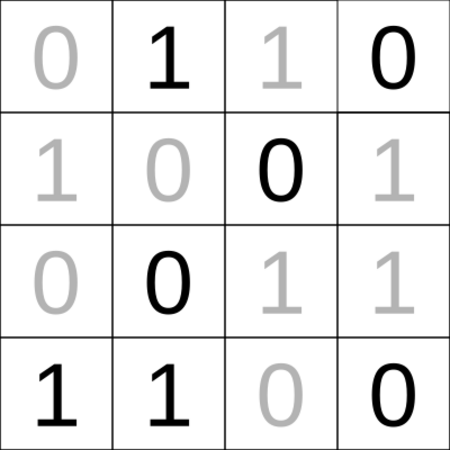Takuzu facts for kids
Takuzu, also known as Binairo, is a fun logic puzzle. It's like a number game where you fill a grid with two symbols, usually 1s and 0s. The goal is to follow some simple rules. You need to have an equal number of 1s and 0s in every row and column. Also, you can't have more than two of the same symbol next to each other. Another rule is that no two rows or columns can be exactly the same. Just like Sudoku, some squares are already filled in for you to start.
Contents
What is Takuzu Called?
This puzzle has many names! Some common ones are Binairo, Takuzu, Binero, and Binary Puzzles. You might also hear it called Tic-Tac-Logic or Eins und Zwei. The names "Binairo" and "Takuzu" are actually protected in Europe.
Different Symbols and Grid Sizes
The name often tells you what symbols are used. For example, "Binary Puzzles" use 1s and 0s, which are binary numbers. "Tic-Tac-Logic" uses X's and O's, like the game tic-tac-toe. "Eins und Zwei" uses 1s and 2s. But many names can be used for any pair of symbols. You can even use black and white circles or squares! Any two different numbers, letters, colors, or pictures can work.
The puzzle grids can be different sizes. Since you need an equal number of both symbols in each row and column, the number of rows and columns is always even. Grids are often square, like 6x6 or 10x10. Common sizes range from 6x6 up to 20x20. You can even find very large puzzles, like ones that are 30x40 squares big!
How to Solve Takuzu Puzzles
Solving Takuzu puzzles means using logic to figure out where each 1 or 0 goes. Here are the main rules and tips to help you:
Rule 1: Equal Numbers in Rows and Columns
Each row and each column must have the same number of 0s and 1s. For example, in a 6x6 grid, every row and column must have three 0s and three 1s.
- If a row or column already has enough 0s, then all the empty spots in that row or column must be filled with 1s.
- The same goes for 1s: if a row or column has enough 1s, the rest must be 0s.
- Example: If a row is `1xx101` in a 6x6 grid, you know it needs three 0s and three 1s. It already has three 1s and one 0. So, the two empty spots must be 0s, making it `100101`.
Rule 2: No More Than Two Same Symbols Together
You cannot have more than two of the same symbol next to each other, either horizontally or vertically.
- If you see two of the same symbol side-by-side, the squares next to them must be the other symbol.
- Example: If you have `xxx00x`, the empty spots next to the `00` must be 1s, so it becomes `xx1001`.
- If you see two of the same symbol with an empty square in between, that empty square must be the other symbol. If it were the same symbol, you would have three in a row.
- Example: If you have `x1x1xx`, the middle empty spot must be a 0, making it `x101xx`.
Rule 3: Eliminate Impossible Options
Sometimes, you can figure out a square by seeing what can't be there.
- Try placing a 0 or a 1 in an empty square. If that choice breaks any of the rules (like creating three in a row or making it impossible to balance the numbers in a row/column), then that choice is wrong. The square must be the other symbol.
- Example: In a 6x6 grid, if you have `110xxx` and you try to put a 1 in the last spot (`110xx1`), you might find that to balance the row, you'd have to create `110001`, which has three 0s in a row. So, the last spot cannot be a 1; it must be a 0 (`110xx0`).
Rule 4: Unique Rows and Columns
Every row must be unique, and every column must be unique. No two rows can be exactly the same, and no two columns can be exactly the same.
- If you have two rows that are almost identical, you can use this rule to figure out the last few spots.
- Example: If you have one row `100101` and another row that starts `1001xx`, you know the second row cannot also be `100101`. So, the last two spots must be `10`, making the second row `100110`.



